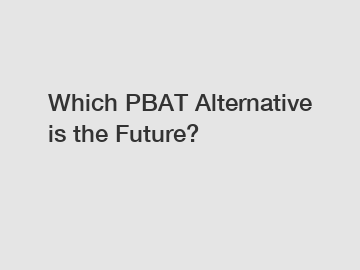Which PBAT Alternative is the Future?
Which PBAT Alternative is the Future?
One of the main contenders for a PBAT alternative is polylactic acid (PLA). PLA is a bioplastic derived from renewable resources such as corn or sugarcane. It offers similar biodegradability as PBAT and has gained popularity in various applications, including packaging and disposable products. PLA's production process emits fewer greenhouse gases compared to conventional plastics, making it an environmentally friendly choice. Furthermore, PLA can be composted, providing a valuable source of organic matter for soil. Its versatility and eco-friendly properties make PLA a strong candidate for the future of biodegradable plastics.
Another potential PBAT alternative is polyhydroxyalkanoates (PHA), a family of biodegradable polymers produced by microorganisms through fermentation processes. PHA can be easily broken down by bacteria in various environments, including soil and water. This characteristic makes PHA an attractive option for reducing plastic waste in landfills and oceans. Moreover, PHA can be produced from renewable resources, such as plant oils and sugar, making it a sustainable choice. Although PHA's production costs are currently higher than those of PBAT, ongoing research and development efforts are focused on reducing these costs to make PHA a more economically viable alternative.

Although both PLA and PHA show promising potential as PBAT alternatives, each has its limitations. PLA, for instance, has lower thermal stability than PBAT, limiting its use in applications that require high-temperature resistance. Additionally, PLA can take a longer time to degrade under certain conditions, hindering its complete replacement of PBAT. On the other hand, PHA's high production costs pose a challenge for its widespread adoption in commercial applications. However, ongoing advancements in technology and manufacturing processes are addressing these limitations, creating a more favorable landscape for the future use of PLA, PHA, or a combination of both as PBAT alternatives.
The adoption of PBAT alternatives holds immense significance in addressing the global plastic waste crisis. As traditional plastics continue to accumulate in landfills and pollute our oceans, the urgency to transition to sustainable alternatives becomes undeniable. PBAT alternatives offer a more environmentally friendly solution by reducing plastic waste and minimizing the carbon footprint associated with plastic production. Additionally, the widespread use of biodegradable plastics can raise awareness among consumers about the importance of responsible waste management and encourage sustainable habits.
In conclusion, the future of PBAT alternatives lies in the development and adoption of sustainable alternatives such as PLA and PHA. Both materials possess biodegradability and are derived from renewable resources, making them attractive choices for the production of environmentally friendly plastics. While each alternative has its limitations, constant innovation and advancements in technology will likely overcome these challenges. The transition to biodegradable plastics not only addresses the pressing issue of plastic waste but also promotes a more sustainable future for our planet.
For more biodegradable branded plastic bags, biodegradable bags from starch, disadvantages of pbatinformation, please contact us. We will provide professional answers.

Comments